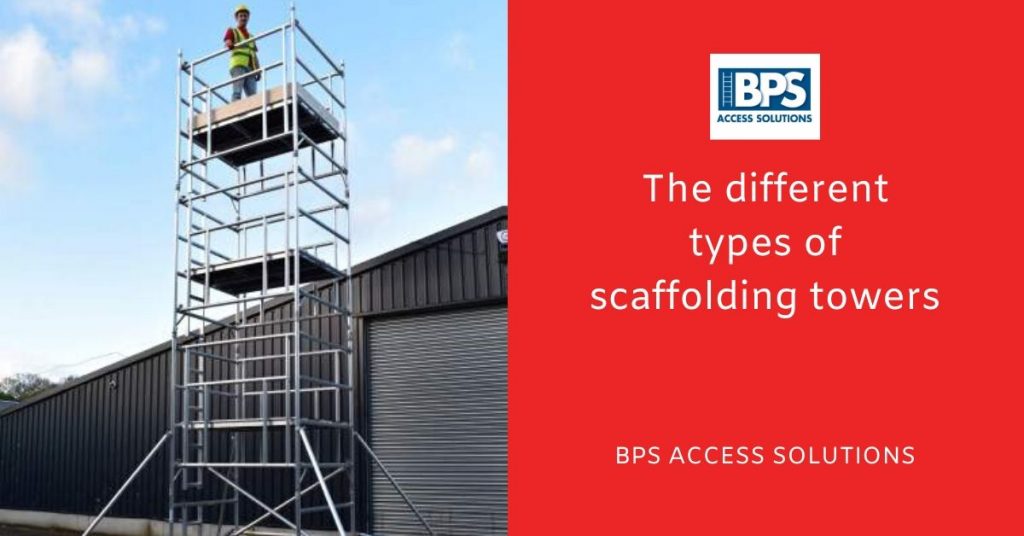The Different Types of Scaffolding
Scaffold towers combine the accessibility of ladders with the strong, temporary structure of traditional scaffolding. Scaffolding consists, usually, of tubes and wooden boards made up to create a strong and stable platform from which to carry out various projects.
The main features of tower scaffolding, which make it a superior alternative to ladders for many working situations, are its height and stability.
Generally, scaffolding towers come with four legs and a much stronger frame, thanks to additional support struts and crossbeams. A wider footing allows these structures to be built and used safely at greater heights than normal ladders. Guard rails and strong working surfaces also allow users to safely operate equipment with both hands at height.
Because different types of scaffolding towers are designed with different purposes in mind, it can be hard to know which should be used in any given circumstance. Below we’ve outlined some of the main types of tower scaffolding, what they’re good at and how to recognise them.
Types of Scaffold
Supported scaffolding
Supported scaffolding has a number of key components which are required to keep the structure held firmly in place, including poles, legs, posts, frames and uprights. The scaffolding structure is then kept in place by supports, which can come in the form of outrigger beams or other rigid structures. They have a range of uses including being used for building construction jobs, painting, window cleaning and more.
There are many types of scaffolding that are classed as supported scaffolding systems.
- Standard Tower Scaffolding System – This is a modular type of scaffold, assembled vertically. It is mainly used for reaching tall heights and providing a stable platform for workers. Its structured and easy-to-assemble design makes it a popular choice for most construction projects.
- Systems Scaffolding – As the name suggests, system scaffolding is a flexible network composed of many different components, including posts, cross braces, and boards.
- Bricklayer’s Scaffolding – Also known as single scaffolding, this is typically used in brick masonry work. It comprises a single frame of ledgers, standards, and putlogs, providing a sturdy working platform for bricklayers at various heights.
- Patented Scaffolding – Usually made up of aluminium or steel scaffolding, patented scaffolding is equipped with special couplings and frames.
- Single Scaffolding – Mostly used for brick masonry, single scaffolding is made up of one row of standards connected longitudinally by ledgers. Since there is single scaffolding, there are also double scaffolding systems, details are below.
- Independent Scaffolding – This type of scaffolding, also known as double scaffolding, has standards on both sides of the working platform, making it ‘independent’ of the structure. It provides a secure and stable platform and is often used when the wall is too weak to support putlogs or for stone masonry.
Suspended Scaffolding
Although not strictly a form of scaffolding tower, suspended scaffolds perform much the same function. Instead of being supported by legs, suspended scaffolding is often used to suspend platforms for jobs such as window cleaning from the top of tall buildings or other very tall structures. This creates a working platform not connected to the ground.
Many high-rise buildings have small cranes which can be used to suspend and lower window-cleaning platforms. In the case of construction sites, temporarily suspended scaffolding systems can be installed to lift building materials to the top of the structure or allow workers to work against the side.
A suspended scaffold can also be a good alternative for use in situations where the ground surface is unsuitable for erecting a normal tower scaffold.
Mobile Scaffolding System
Mobile scaffolds, also known as rolling scaffolds, offer the construction industry the unique advantage of mobility. Unlike their static counterparts, these types of scaffolding are mounted on casters or wheels, allowing for easy movement across the work site. This means that tasks can be carried out across large areas without the need to dismantle and reassemble the scaffold at each point of work, which can save significant time and effort.
Rolling Scaffolding: A variant of mobile scaffolding, rolling scaffolding is equipped with lockable wheels. This means it can be safely moved to different locations as needed, and then securely locked in place for stable, secure work. It’s a versatile tool for tasks such as painting, plastering, and maintenance work across large, flat areas. Safe use of rolling scaffolding requires that it always be locked in place while in use, and never moved while someone is on it.
Special Scaffolding
Specialised scaffolds are designed for specific tasks and scenarios where conventional scaffolding may not provide optimal functionality. Each type of specialised scaffold has its unique set of features, advantages, and applications.
Cantilever Scaffolding: Also known as needle beam scaffolding, cantilever scaffolding is supported on a series of cantilever beams or needles extended from a building’s openings or holes. It’s used when the ground doesn’t permit the setup of standards, such as over pavements or roads, or where the ground is weak to support standards.
Needle Scaffolding: This design is similar to cantilever scaffolding but often used in specific circumstances where it isn’t possible to establish support on the ground. ‘Needles’ are taken out through holes in the wall, and a platform is then built on these needles.
Trestle Scaffolding: Trestle scaffolding is typically used for indoor work such as painting or repairs. It consists of movable ladders or tripods supporting a work platform. It’s easy to move and set up, making it ideal for work that covers a large area.
Modular Scaffolding: As the name suggests, this type of scaffolding consists of horizontal and vertical components that are combined to create the structure. It is a versatile piece of equipment that can be customised to meet a range of project needs.
Double Scaffolding: This is ideal for construction or repair work involving work with sturdy structures, like stone masonry. The “double” comes from the use of two rows of scaffolding, which provides added support and safety, an important consideration when dealing with heavy stone walls or brick masonry.
Coupler Scaffolding
Coupler scaffolds are an essential system within the broader framework of construction scaffolding. It earns its name from the use of specialised components called couplers, or clamps, that fasten the various structural members of the scaffold together. Unlike other scaffolding types, where the focus might be on the material or overall structural design, the focus in coupler scaffolding is on these unique connecting elements.
Types of Scaffolding – Material
Wooden Scaffolding
As an age-old method, wooden scaffolding utilises planks and poles crafted from wood to provide sturdy support for construction and repair tasks. Still widely used, especially for smaller-scale projects, its popularity stems from its economic viability and the simplicity of its assembly process.
Moreover, it’s an environmentally friendly choice due to wood being a natural, renewable material. However, caution is required when using wooden scaffolding; the material is sensitive to the elements and may be vulnerable to pests. Therefore, diligent maintenance is key to ensuring the longevity and safety of this type of scaffolding.
Metal Scaffolding
For many modern construction tasks, metal scaffolding – predominantly composed of steel or aluminium – serves as the go-to solution. Steel variants of scaffolding stand out due to their unbeatable durability and robustness, becoming the prime choice for towering, large-scale structures. The resilience of steel against the elements and its fire-resistant nature enhance the safety measures for onsite workers. Types of steel scaffolding like tube and clamp scaffolding bring flexibility to the design and assembly process.
In contrast, aluminium scaffolding provides a lighter alternative to its steel counterpart. Its reduced weight makes it a convenient option for projects that necessitate frequent repositioning or moving of the scaffold structure.
Bamboo Scaffolding
In regions abundant with natural resources, such as many Asian countries, bamboo scaffolding is often used. Despite lacking the rigid strength of metal scaffolding, bamboo proves to be a formidable material due to its surprising resilience and flexibility, reducing the risk of cracking under pressure. As bamboo is a renewable resource, its use contributes to more environmentally conscious construction practices. Nevertheless, erecting bamboo scaffolding requires a high degree of expertise and is typically preferred for smaller projects or restoration works.
Conclusion
If you would like to find out more about the wide variety of scaffolding systems, please contact us today



